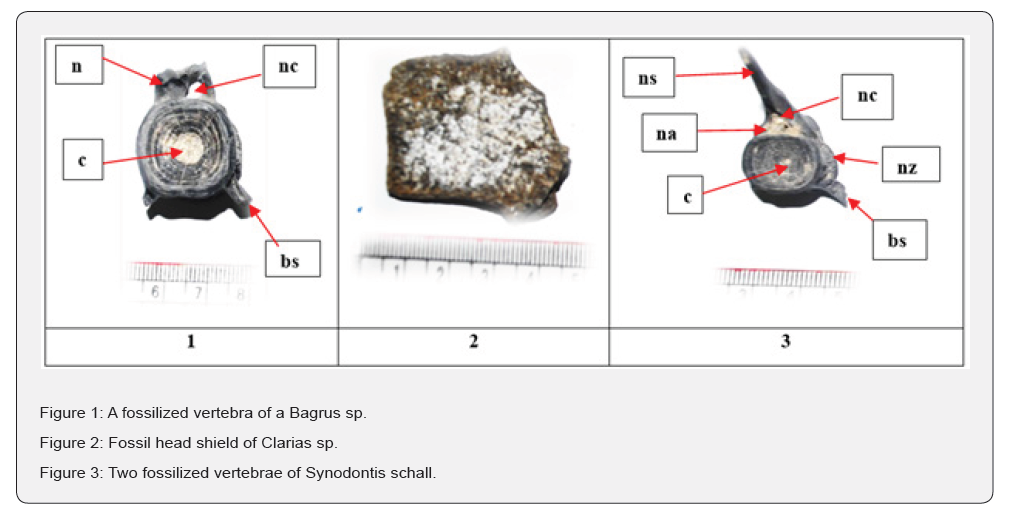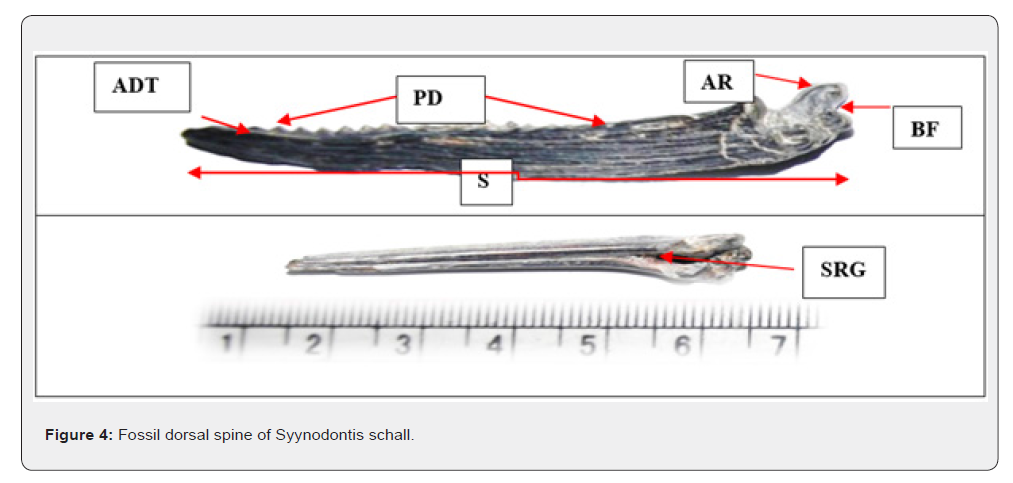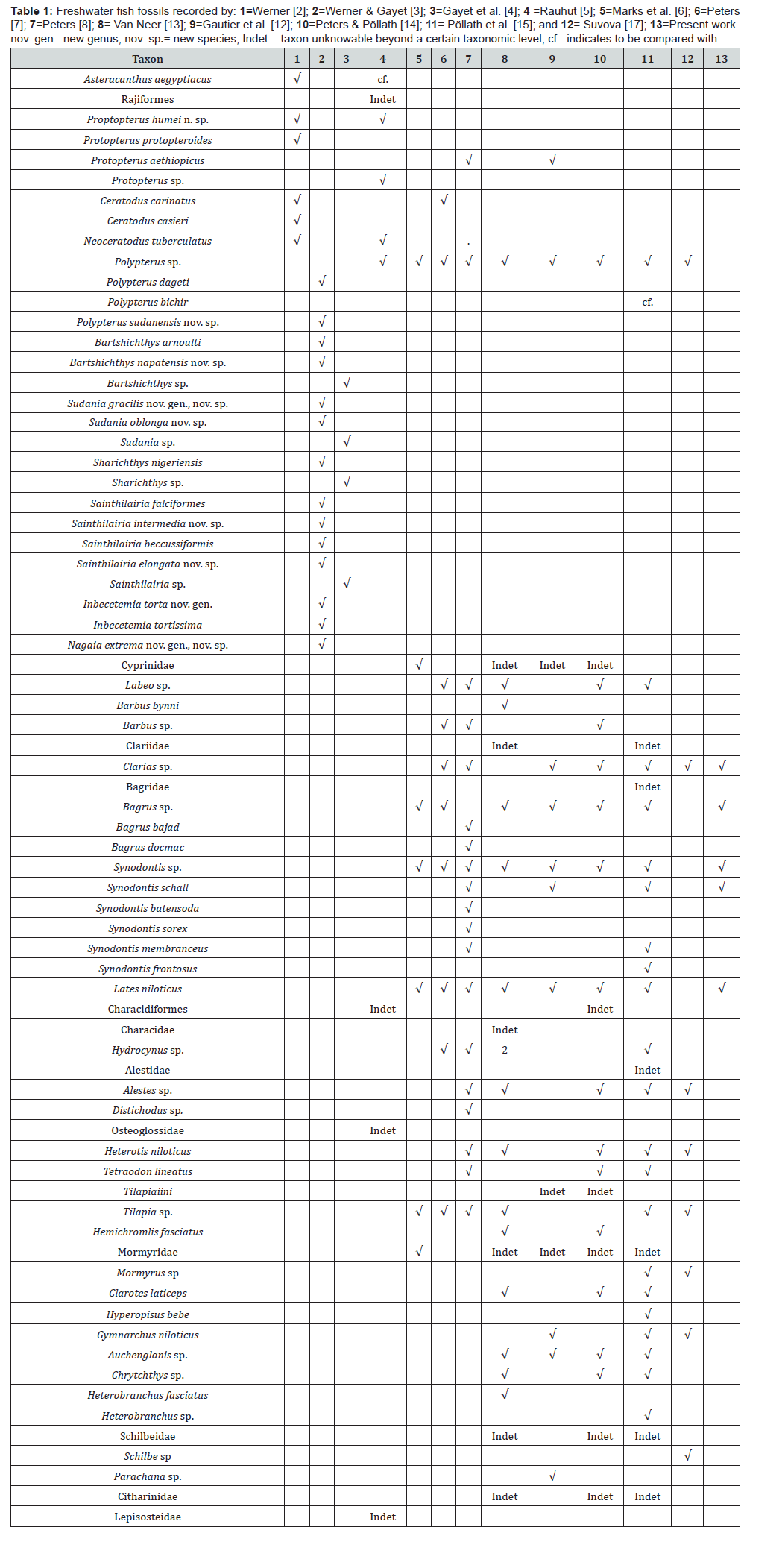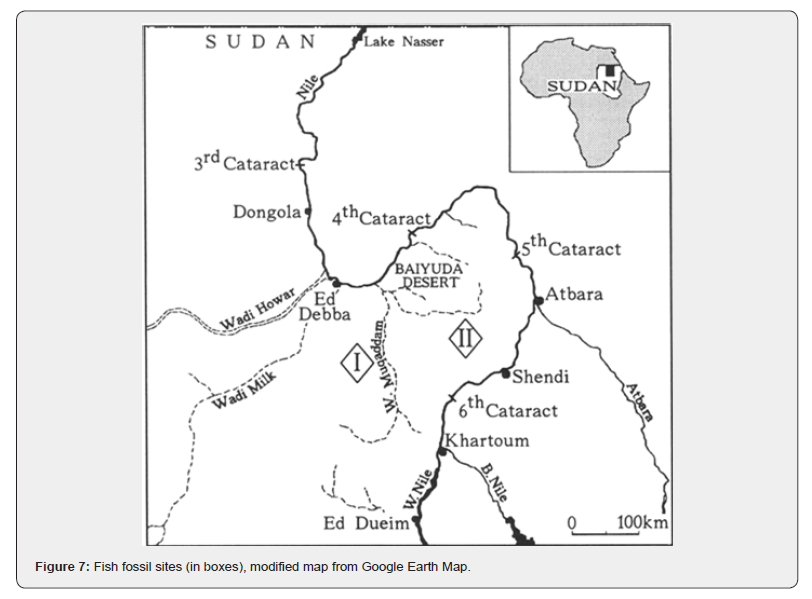Abstract
The study described fossil remains of Clarias sp., Synodontis schall, Lates niloticus and Bagrus sp. collected from Al Ga’ab Depression, and deposited at Sudan Natural History Museum. It incorporated findings from paleontological surveys in dessert wadis that have undergone aridification in Sudan, as well as archaeological sites distributed along the Nile system. The assemblage includes representatives from nine indeterminate families, two species tentatively assigned as cf. Asteracanthus aegyptiacus and cf. Polypterus bichir and 53 species, of which eight are new species. Additionally, three new genera- Sudania, Inbecetemia and Nagaia- are described. Fossils recovered from Wadi Al Milk include cartilaginous freshwater fishes Asteracanthus cf. aegyptiacus, indeterminate Rajiformes and indeterminate members of Lepisosteidae. The fish fossils from Al Ga’ab Depression, lower Atbara, the Nile, Wadi Hawar and the 6th cataract are all extant in the Nile and its tributaries. Significantly, the fossil taxa identified from Al Ga’ab Depression, Lower Atbara, the Nile, Wadi Hawar, and the Sixth Cataract region correspond to extant species currently found in the Nile River and its tributaries, suggesting a strong continuity in freshwater ichthyofauna across time.
Keywords:Paleo-depression; Fish; Freshwater; Fossils; Sudan
Introduction
Paleontological investigations in Sudan have revealed remains fossil remains of freshwater fish species in regions that were formerly submerged under freshwater bodies millions of years ago (MYA). The majority of these fossils are dated to the Cretaceous period (approximately 145 to 66 million years ago), [1-5] Additional specimens have been dated to more recent geological periods, including the Late Pleistocene to Early Holocene (circa 129,000 to 11,700 years ago “YA”) [6], as well as the Mesolithic period (approximately 10,000 to 8,000 YA) [7,8]. These fossil accumulations represent several orders, notably Polypteriformes, Siluriformes, and Characiformes, which are still extant species in the Nile River system and its tributaries [9].
Al Ga’ab Depression, identified as a Holocene paleolake (dated to approximately 11,700 years ago), has been the subject of multidisciplinary research. Its archaeology, ethnography, and ecological context have been explored in detail by [10], while its associated faunal remains were studied by [11].
Numerous researchers have investigated the freshwater fish fossils of Sudan. Marks et al. [6] identified fish remains in the Upper Atbara River Valley representing five species, two families, and an indeterminate Percomorphi, dated to the Late Pleistocene and Early Holocene. Mesolithic fish assemblages from the central Sudanese Nile and lower Atbara River were examined by [7], while Peters [8] analyzed Holocene fish remains from sites at Abu Darbein, El Damer, and Anebis. Gautier et al. [12] recorded fish remains from the early Khartoum occupation on Jebel Umm Marrahi (JUM). Van Neer [13] investigated a Holocene site in Wadi Howar, recovering fish fossils representing six indeterminate families and 14 genera, including five identified species. Werner [2] studied the fossils of fish collected from Wadi Al Milk Formation. His material dated to Early Cretaceous. Werner & Gayet [3] assigned the Cenomanian fish fossils to the Late Cretaceous. Gayet et al. [4] described strange Polypteriformes, dated to the Upper Cretaceous of Wadi Al Milk Formation, based on finlet spine morphology. They found spines of the fossil Bartschichthys, Sudania, Saharichthys and Sainthilairia, whose spine structures show morphological similarities to those of extant Polypterus. Rauhut [5] whose prime concern was Dinosaur Fauna from the Late Cretaceous from Cenomanian of Sudan, also documented six fossilized fish species. Additional ichthyofaunal remains from Wadi Howar have been studied by [14,15] and fish fossils from Wadi Al Mugadam were examined by [16].
Suvova [17] archaeologically investigated Alsabaloka mountain 3.5km northwest of the 6th cataract. She identified fossil remains representing eight freshwater fish species. However, no specific chronological framework was provided for these remains.
The primary objective of the present study is to document and analyze the freshwater fish fossils from the Al Ga’ab Depression. It also aimed to synthesize relevant paleontological and archaeological findings on ichthyofaunal remains from Sudan focusing on significant paleontological contributions, such as the first records and newly described species. It also intended to provide a reference list for future research on the subject in Sudan.
Material and Method
The study area
Al Ga’ab Depression is located to the west of Dongola, within North African Sahara region, and is readily accessible via established motor tracks. The depression extends approximately 165km in length, with a variable width ranging between 3 and 8km, encompassing an estimated area of 700km². Its geographical coordinates are approximately: 19º 38.00N, 30º 18.25E; 19º 39.00N, 30º 7.50E; 18º 33.800N, 29º 59.800E; 18º 32.250N, 30º 22.800E [10].
The climatic conditions in the region are hyper-arid. June represents the peak of summer temperatures, with a recorded maximum of 44.4°C and minimal precipitation of 0.8mm. The highest relative humidity, observed in January, reaches up to 30%. Prevailing wind patterns are predominantly from the north to north-northwest, with a mean wind speed of 9.6 knots [10].
Fish fossils from Al Ga’ab Depression
Fish fossils were recovered from a meandering Holocene paleochannel, particularly in the vicinity of Ga’ab Al Lagia located approximately 18km west of the Nile at 19⁰27’N and 30⁰15’E. The fossils were naturally exposed on the surface and their collection did not require sediment sieving. A representative sample, sufficient to document the taxonomic diversity and augment the existing holdings of the Sudan Natural History Museum, was assembled. The collected specimens were catalogued under accession codes AD-24 to AD-26 within the museum’s repository.
Photography was made by a Nikon DX (AF-SNIKKOR 18- 55mm 1:3.5-5.6G) digital camera.
Results and Discussion
The collected fish fossils belonged to Bagrus sp., Clarias sp., Synodontis schall (order Siluriformes) and Lates niloticus (order Perciformes).
Classification and description of fossilized vertebra of Bagrus sp.
Phylum: Chordata (Haeckel, 1974).
Class: Actinopterygii (Klein,1885), Family: Bagridae (Bleeker,1858), Genus: Bagrus (Bosc, 1816).
The vertebra is probably from the mid-trunk. Its centrum (c) bears clear growth rings (Figure 1). Signs of cracks can clearly be seen on the ventral face of the centrum. The neural arch (na) and neural canal (nc) are clear. The transverse section of the neural canal is longer than wider. neural spine is broken and its length cannot be estimated; neural zygaphysis (nz) can hardly be distinguished. The spines ‘ribs’ (bs) are clearly broken. The diameter of the vertebra is 23mm axially and 24mm laterally and of the nc is 4mm.

Classification and description of fossilized head shield of Clarias sp.
Family: Clariidae (Bonaparte,1846), Genus: Clarias (Scopoli, 1777).
One head shield of Clarias sp., bearing numerous tiny indentations was found (Figure 2). Compared with recent time collection and due to the largeness of the shield it is probably belong to C. garipenius. The maximum dimensions of the shield are 44x82mm.

Classification, description of fossilized vertebrae and a dorsal fin spine of Synodontis schall.
Family: Mochokidae (Jordan, 1923), Genus: Synodontis (Cuvier, 1816), Species: schall (Bloch & Schneider, 1801).
Two vertebrae (Figure 3) and one dorsal fin spine (Figure 4) were collected. Figure 3 showed the centrum of the vertebra (c) with clear growth rings in the right vertebra. The centrum of the vertebra to the left measured 22mm on the horizontal axis and 22mm on the vertical axis. The vertebra to the right measured 16mm on the horizontal axis and 14mm on the vertical axis. The neural arches (na) surround the neural canal (nc) 3mm in diameter and end up with 18mm long neural spine (ns). The neural zygaphysis (nz) and a remain of a broken spine ‘ribs’ (bs) are apparent in the vertebra to the right. The spines of the left vertebra are completely distorted.
The dorsal fin spine of S. schall (Figure 4) in left lateral views (top) and anterior views (bottom) is 44mm in length. The width of its articulation (AR) is 5.3mm and tapers gradually to the tip ending in unsharpened structure of 1.3mm, probably due to erosion. The horizontal position shows the details of the parts of the spine. The anterior distal tip of the spine (ADT) is clearly blunt. There are 12 posterior dentations (PD) and are almost uniformly separated. The shaft of the spine (S) is a pit curved with clear ridges on the lateral side. The ventral articular process and basal fossa (BF) Figure 4 are intact. Their structural build up gave the spine its mechanical properties with respect of attachment and articulation. The articulation is maintained by means of a well-developed basal process. The middle and posterior surface of the spine shaft showed clear ridges and grooves (SRG) Figure 4 bottom.
A fossil dorsal spine of a Synodontis sp. (Figure 5) with no apparent serration on both sides probably due to erosion. The material needs to be identified to the species level.
Classification and description of fossilized vertebrae of Lates niloticus.
Family: Latidae (Jordon, 1888), Genus: Lates (Cuvier, 1828), Species: niloticus (L., 1758).
Both vertebrae are with broken neural arches and hence neither neural canal nor neural spine are found (Figure 6). The vertebrae are probably trunk vertebrae. The centrum (c.) with clear growth rings and bears clear cracks. The centrum is elongate and nearly flat. The vertebra measured 55.6mm x 50mm. The spines ‘ribs’ (bs) is clearly distorted.
Fish fossil collection sites and potential sites
The freshwater fish fossils assemblage from Sudan includes a diverse range of taxa collected from multiple localities (Figure 7; Table 1). The current collection comprises representatives from nine indeterminate families, two cf. species, and 53 identified species, including eight species new to science. Additionally, three new genera have been described: Sudania gracilis, Inbecetemia torta, and Nagaia extrema. Notably, fossils of Bagrus sp., Clarias sp., Synodontis sp., and Lates niloticus were found at Ga’ab Al Lagia, approximately 18 km west of Dongola (Figure 1-6). This site has proven to be a significant Holocene paleochannel locality for vertebrate fossil preservation.

In the Upper Atbara River Valley, Marks et al. [6] reported Late Pleistocene to Early Holocene freshwater fish fossils, including Polypterus sp., Mormyridae, Cyprinidae, Synodontis sp., Bagrus sp., Lates niloticus, Tilapia sp., and indeterminate Percomorphs. From the Cenomanian deposits of the Wadi Milk Formation in northern Sudan, Polypteriformes have been documented [1,3]. Late Cretaceous investigations in both Niger and northern Sudan [4] recovered finlet spines of fossil polypterid genera including Bartschichthys, Sudania, Saharichthys, and Sainthilairia, which exhibit symmetrical morphology comparable to extant Polypterus. In contrast, the fin spines of Inbecetemia and Nagaia are morphologically distinct, displaying asymmetry and marked divergence from modern forms. Further work by [3] in the Wadi Milk Formation (dated to approximately 100.5–93.9MYA) yielded 14 fossil specimens of Polypteridae. Two fossil species of Polypterus sp. were described based on scale morphology. The assemblage from this site includes six indeterminate families, 13 genera, and five identified species, supporting the interpretation that Polypteridae were highly diverse during the early Late Cretaceous. Fish fossils of Wadi Al Milk also feature freshwater cartilaginous taxa such as Asteracanthus cf. aegyptiacus, Rajiformes indet, the Gar fish Lepisosteidae indet [5], fossils of Polypteridae indet, Osteoglossidae indet, Characideformes, Protopterus humei, Protopterus nov. sp., and Neoceratodus tuberculatus [2,4,5]. Bufferaut et al. [18] further proposed that their specimen of Protopterus cf. from the Upper Cretaceous represents a form intermediate between Protopterus protpteroides and ? Protopetrus regularis.
According to Peters & Pöllath [15], ichthyofaunal remains from the West Nubian Paleolake region (WNPR) and Jebel Tageru- Wadi Magrur-Meidob Hills (JTWMMH) include fossil specimens of Heterobranchus sp., and Tetraodon lineatus, and share several taxa with Wadi Hawar-Jebel Rahib (WHJR) area, such as Polypterus sp., Labeo sp., Clarias sp., Bagrus sp., Synodontis sp., L. niloticus, and indeterminate members of the tribe Tilapiini. Peters & Pöllath [15] reported Cyprinidae indet from WHJR and JTWMMH, and S. schall from WNPR. Additionally, indeterminate cyprinid remains (Cyprinidae indet.) were reported from both WHJR and JTWMMH, while Schilbe mystus (formerly Schilbe schall) was identified in the WNPR. Holocene fish assemblages from Wadi Hawar (Table 1) include a diverse range of taxa: Polypterus cf. bichir, H. niloticus, S. frontosus, S. schall, S. membranceus, L. niloticus, Clarotes laticeps, Hyperopisus bebe, G. niloticus, T. lineatus and species of Polypterus, Clarias, Bagrus, Labeo, Synodontis, Mormyrus, Alestes, Hydrocynus, Auchenglanis, Chrytchthys, Heterobranchus [4,13]. Indeterminate remains were also attributed to the families Mormyridae, Alestidae, Citharinidae, Bagridae, Schilbeidae, Clariidae and Tilapiini [4,13].


Mallinson et al. [16] identified remains of tilapiine cichlids and catfishes in the Holocene deposits at Almoltaga of Wadi Al Mugadam. Pöllath et al. [15] reported the absence of Arapaimidae (Osteoglossiformes) Channidae (Perciformes) in the Holocene ichthyofaunal record north of Khartoum, indicating that these taxa, once present, are no longer encountered in the region’s current fish fauna. Peters [7] investigated Mesolithic fishing sites along the central Sudanese Nile and lower Atbara River. He listed fossils of the following genera: Protopterus, Polypterus, Heterotis, Labeo, Barbus, Clarias, Bagrus, Synodontis, Lates, Hydrocynus and tilapias. Further, Peters [8] analyzed Holocene fish assemblage from Au Darbein (lower Atbara), El Damer and Anebis (on the Nile) Figure 7. He noted uneven distribution of Protopterus aethiopicus, Polypterus sp., Heterotis, Labeo, Barbus, Clarias sp., Bagrus, S. schall, Synodontis batensoda, Synodontis sorex, Synodontis membranceus, Synodontis sp., Bagrus bajad, Bagrus docmac, Distichodus sp., T. lineatus, L. niloticus, Hydrocynus sp., Alestes sp., and tilapias. Peters [8] reported the absence of representatives from Protopteridae, Polypteridae, Arapimidae, Gymnarchidae, Channidae, Schilbiade and Malapteruidae in the Holocene assemblages from Abu Darbein. Ibrahim & Mahmoud [19] made recent times records for Schilbiade and Malapteruidae from mid Atbara River.
Suvova [17] investigated an archaeological site west of Alsabaloka mountain 3.5km north west of the 6th cataract (Figure 7). They found fossils of Polypterus sp., Heterotis niloticus, Clarias sp., Bagrus sp., Schilbe sp., Synodontis sp., Mormyrus sp., L. niloticus, Alestes sp., and tilapias cichlids. Comparative analyses revealed fish fossil remain; of Polypterus sp., Heterotis niloticus, Clarias sp., Bagrus sp., Schilbe sp., Synodontis sp., Mormyrus sp., Lates niloticus, Alestes sp., and tilapiine; recovered from the lower Atbara River (Abu Darbein), the Nile sites at El Damer and Anebis [10,11], Jebel Umm Marrahi (JUM) [12], Wadi Howar [14], and the Sixth Cataract region [17]. All these are currently extant in the Nile and its tributary systems.
Peters [20] analyzed ichthyofaunal remains from Khartoum hospital excavation site. He the following taxa: Polypterus sp., Labeo sp., Clarias sp., Synodontis sp., Clarotes sp., Lates cf. nioticus, Tilapia sp., Bagrus sp. and Hydrocyon forskalli, now known as Hydrocynous forskalli. All these taxa are currently extant in the Nile system [9]. Investigations of Holocene Mesolithic deposits at Al- Khday, located along the White Nile west of Khartoum by Linseele & Zerboni [21] and Dunne et al. [22] revealed that approximately 90% fish remains belonged to Clarrids and L. niloticus. These taxa represent the dominant ichthyofaunal components in Holocene assemblages from the Sudanese Nile Basin.
Significant geomorphological and climatic changes during the Paleocene epoch (66-56MYA) in northern and eastern Africa substantially altered regional hydrological regimes [23]. These transformations likely resulted in the isolation of certain fish populations within confined watercourses and wadis in Sudan, leading in some cases to fossilization and localized extinction due to increasing aridification. In their comprehensive review of African freshwater fish fossils, Otero et al. [24] gave minimal consideration to the ichthyofaunal fossil record of Sudan, with only brief references to earlier studies [1,4].
The discovery of teleost fish vertebrae in graves at Sedeinga, north of Dongola, dated to the Meroitic period [25], is likely associated with the ritual deposition of food and drink offerings— such as wine and fish—in accordance with earlier Nubian funerary practices reflecting beliefs in the day after.
Fish fossil remains have been documented in several Sudanese palaeohydrological systems, including Wadi Al-Milk [2], Wadi Howar [12], Wadi Al-Mugadam [16], and the Al Ga’ab Depression (present study). Additional wadis with high potential for yielding ichthyofaunal fossils, but which remain unexplored, include Abu Dom, Kabna, Abu Siba’a, Haraz, Abu Hamad, Tibka, Barhol, Subbar, Kirbekan, and Khor Shingawi in the Bayuda Desert, as well as Gargood, Al Khowi, Farja, and Wadi Um Bkool in the Nubian Desert. Furthermore, the seasonal riverbed of Khor Abu Habil— which originates in the Nuba Mountains and discharges into the White Nile south of Kosti during periods of intense rainfall—may also contain fish fossil deposits, warranting future investigation.
Conclusion
Polypterus sp. was represented by four distinct species and was recorded in 67% of the studies reviewed. Two indeterminate orders, Rajiformes and Characiformes, were also identified but could not be further resolved.
Fossil specimens that could not be classified beyond the family level were attributed to the following families: Cyprinidae, Clariidae, Bagridae, Mormyridae, Alestidae, Characidae, Osteoglossidae, Schilbeidae, Citharinidae, and Lepisosteidae. Six new species were described: Polypterus humei, P. sudanensis, Bagrus napatensis, Synodontis intermedia, S. elongata, and S. oblonga.
Two new genera and species Sudania gracilis and Nagaia extrema were identified. Additionally, one new genus Inbecetemia torta, was described.
Ethics
Human and animal rights, availability of data and materials are not applicable.
Acknowledgment
Al Ga’ab archaeological, ethnographical and ecological project supported the visit to the study site.
References
- Werner C (1993) Late Cretaceous continental vertebrae faunas of Niger and Northen Sudan. In: U Thorweihe, Schandelmeierm H (Eds.) Geoscientific Research in Northeast Africa, Balkeim, Rotterdam, pp. 301-405.
- Werner C (1994) Die kontinentale Werbeltierfauna aus der enteren Oberkreide des Sudan (Wadi Milk Formation). Berliner Geowiss Abh E13: 221-249.
- Werner C, Gayet M (1997) New Fossil polypteridae from the Cenomanian of Sudan. Evidence of their high diversity in the early Late Cretaceous. Cybium 21(1): 67-81.
- Gayet M, Meunier FJ, Werner C (1997) Strange polypteriformes from the Upper Cretaceous of in Becetem (Niger) and Wadi Milk Formation (Sudan). Geography, Environmental Science 30(Supplement 1): 249-255.
- Rauhut OWM (1999) A Dinosaur Fauna from the Late Cretaceous (Cenomanian) of Northern Sudan. Palaeont Afr 35: 61-84.
- Marks A, Peters J, Van Neer W (1987) Late Pleistocene and Early Holocene occupations in the Upper Atbara River Valley, Sudan. In: A Close (Ed.), Prehistory of arid North Africa, Dallas: Southern Methodist University Press, pp. 137-161.
- Peters J (1991) Mesolithic fishing along the central Sudanese Nile and the lower Atbara. Sahara 4: 33-49.
- Peters J (1995) Mesolithic subsistence between the 5th and the 6th Nile cataract: The archaeofaunas from Abu Darbein, El Damer and Aneibis (Sudan). In: R Haaland, AA Magid (Eds)., Aqualithic sites along the rivers Nile and Atbara, Sudan. Bergen: Alma Mate, pp. 178-244.
- Mahmoud ZN, Hagar EA, Abdalla MYM (2024) Fish diversity in the Nile system and ephemeral water bodies in Sudan: Records and a review. International Journal of Fisheries and Aquatic Studies 12(4): 1-8.
- Tahir YF (2012) A Holocene Paleolake in Al Ga’ab Depression, Western Desert, Northern Sudan. Sahara 2012: 99-112.
- Mahmoud ZN (2014) The fauna of Al Ga’ab Depression area (Western Dongola), In: Archaeological, Ecological, and Ethnographical of Al Ga’ab Depression Project. Research Season 2013-2014, p. 38.
- Gautier A, Linseele V, Van Neer W (2002) The Fauna of the Early Khartoum Occupation on Jebel Umm Marrahi (Khartoum Province, Sudan) Tides of the desert: contributions to the archaeology and environmental history of Africa in honour of Rudolph Kuper = Gezeiten der Wüste: Beiträgezu Archäologie und Umweltgeschichte Afrikas zu 4.
- Van Neer W (1988) Fish remains from a Holocene site (84/13-19) in Wadi Hawar, Sudan. Archaeozoologia 2: 339-348.
- Peters J, Pöllath N (2002) 4. Holocene Faunas of the Eastern Sahara: Zoogeographical and Palaeoecological Aspects 9th ICAZ Conference, Durham 2002 The Future from the Past. In: Roel CGM Lauwerier, Ina Plug (Eds.), pp. 34-50.
- Pöllath N, Peters J, Jousse H (2008) Archaeobiodiversity of Ichthyofaunas from the Holocene Sahel. In: B Shaw, M Peter, C D Jonathan (Eds.), Animals and People Archaeozoological. Papers in Honour of Ina Plug. Archaeopress, England, pp. 57-74.
- Mallinson M, Mahmoud AA, Fuller D, Smit LMV (2018) Road archaeology in the Wadi Mugadam, SARS Survey from Omdurman to Gabolab: Environmental and Cultural Changes in the Bayuda. In: A Lahwasser, T Karbergg, J Auenmuller (Eds.), Bayuda Studies. Proc of the 1st Int Conf on the Archaeology of Bayuda Desert in Sudan, pp. 209-357.
- Suvova Z (2017) The archaeozoological osteological finds from Sphinx, Sudan & Nubia 21: 43-44.
- Bufferaut E, Bussert R, Brinkmann W (1990) A new nonmarine vertebrate Fauna in the Upper Cretaceous of Northern Sudan.
- Ibrahim MA, Mahmoud ZN (2013) Analysis of Khashm el Girba Lake Fisheries. Sudan Journal of Natural Sciences Series B. Biological Sciences 18: 63-74.
- Peters J (1986) A Revision of the Faunal Remains from Two Central Sudanese Sites: Khartoum Hospital and Esh Shaheinab. In: Archaeozoologia, 5th International Congress of archaeozoologia, Bordeaux, pp. 11-35.
- Linseele V, Zerboni A (2018) Done with fish? A diachronic study of fishing in the Holocene Nile basin of Sudan. Quaternary International 471: 229-240.
- Dunne J, Salvatori S, Maritan L, Mannin K, Linseele V, et al. (2022) Wild food plants, fish and small animals on the menu for Early Holocene Populations at Al-Khday, Central Sudan. African Archaeological Review 39(3): 255-281.
- Kathlyn S (2009) Fossil Fish from the Nile River and Its Southern Basins: In: HJ Dumont (Eds.), The Nile: Origin, Environments, Limnology and Human Use. © Springer, pp. 677-704.
- Otero O, Murray A, Cavin L, Clément G, et al. (2017) African fossil fish. In: D. Paugy, C. Levêque and O/Otero (Eds.). The inland water fishes of Africa Diversity, ecology and human use, pp. 51-82.
- Harcourt-Smith W, Vincent F, De Voogt A (2012) Northern Sudan and Paleoanthropology: Historical Perspectives and Preliminary Results from the AMNH 2011 Survey. Der Antike Sudan 23: 29-33.






























